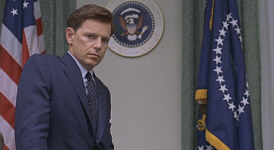 Unfortunately, the lackluster box office performance of Thirteen Days shows that Americans really don’t seem to care much for historical dramas. Actually, that’s not totally true, as other movies prove again and again that stories based on fact can clean up financially. After all, two of the biggest hits of all time - 1997’s Titanic and 1939’s Gone With the Wind - take historical occurrences as their inspirations.
Unfortunately, the lackluster box office performance of Thirteen Days shows that Americans really don’t seem to care much for historical dramas. Actually, that’s not totally true, as other movies prove again and again that stories based on fact can clean up financially. After all, two of the biggest hits of all time - 1997’s Titanic and 1939’s Gone With the Wind - take historical occurrences as their inspirations.
However, both of those films introduced significant liberties and were generally more concerned with romantic affairs than they were with the details of the events themselves. Certainly, we learned about their historical eras, especially in the case of Titanic, but the interpersonal stories maintained the primary focus.
Without question, Thirteen Days took a different path. Historical facts took precedence for this film, and it spent little time with the more sentimental side of the tale. That’s not to say that the movie offered a cold, dry retelling of details, for that wasn’t the case; indeed, much of the film’s drama stemmed from the tension built among the characters. However, the events remained the primary focus, and the flick spent little time with material that didn’t directly relate to the historical occurrences.
In Thirteen Days, the progression of the 1962 Cuban Missile Crisis is examined from the US point of view. During October of that year, US spy planes discovered that the Soviets had placed nuclear missiles on Cuba. As mainly represented by President John F. Kennedy (Bruce Greenwood), the US demanded that these weapons be removed from Cuba, and the movie follows the escalating tension as the two sides oppose each other.
Some of us are far too young to remember this period; I was negative five years old in 1962, so obviously I can’t relate to it. However, the events remain chilling even for those of us who didn’t experience them. Frankly, since October 1962 provided the period in which we came closer to nuclear annihilation than at any other time, I’m rather happy I wasn’t around to go through all that mess.
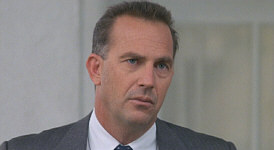 Thirteen Days could have degenerated into a cold history lesson, but the film actually offers a crackling, entertaining look at a scary period. Personally, I was extremely happy that the movie devoted so little time to the more sentimental aspects of the tale. We see enough of the personal toll taken on the policy-makers involved, mainly through presidential assistant Kenny O’Donnell (Kevin Costner). Though I wouldn’t call O’Donnell the film’s main character - this was a true ensemble piece - he clearly functioned as the audience’s “in” for the flick; he attended most of the relevant meetings, but he usually stayed on the sidelines, which is why he could act as our proxy. The scenes in which he interacts with his family were appropriately brief and simple, and they added just the right level of humanity to the proceedings.
Thirteen Days could have degenerated into a cold history lesson, but the film actually offers a crackling, entertaining look at a scary period. Personally, I was extremely happy that the movie devoted so little time to the more sentimental aspects of the tale. We see enough of the personal toll taken on the policy-makers involved, mainly through presidential assistant Kenny O’Donnell (Kevin Costner). Though I wouldn’t call O’Donnell the film’s main character - this was a true ensemble piece - he clearly functioned as the audience’s “in” for the flick; he attended most of the relevant meetings, but he usually stayed on the sidelines, which is why he could act as our proxy. The scenes in which he interacts with his family were appropriately brief and simple, and they added just the right level of humanity to the proceedings.
Otherwise, matters stay heavily oriented toward the facts, and director Roger Donaldson nicely balances all of the different players. Thirteen Days features a very large cast of main characters, and it easily could have been tough to tell them apart. Since I’ve always been interested in the period, it was fairly easy for me to keep things straight, but even neophytes should have little trouble with this aspect of the movie; roles and relationships are made clear enough to maintain order and sensibility.
Thirteen Days offered an acting challenge for many of the performers because they played real-life personalities. In many cases, the actors had a reasonable amount of leeway; after all, O’Donnell is not a well-known figure, so Costner wouldn’t be heavily criticized for any liberties. However, some of the others lacked the same freedom, and that issue especially affected Greenwood’s JFK and Stephen Culp’s Robert Kennedy. While some of the others were public figures - after all, Adlai Stevenson (Michael Fairman) ran for president twice - none remain so familiar to the population as the Kennedy brothers.
This created a particular challenge, but the actors generally were up to the job. Costner, Culp and Greenwood all adopted New England accents for the roles, but they did so with varying success. Culp did best with his, whereas Greenwood and Costner seemed to take differing approaches to the task. As proven during Robin Hood, Costner has never been a match for Meryl Streep when it comes to new voices, and he runs into some trouble as O’Donnell. Interestingly, he sticks with a very heavy accent at first and generally lessens it as the movie continues.
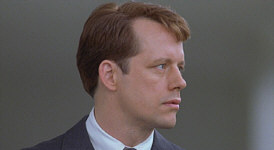 On the other hand, Greenwood went with a lighter approach throughout the film. His accent comes and goes to a degree, but it never seemed as thick as the one displayed by Costner. Oddly, this worked less well for me. Because Costner’s tones started out so heavily, that meant he was able to become more subdued; even when he barely used an accent, I still had its effect in my brain, so I accepted the less deliberate speech. Greenwood’s weaker accent meant that I tended to notice his natural voice more clearly, and that occasionally disrupted the illusion.
On the other hand, Greenwood went with a lighter approach throughout the film. His accent comes and goes to a degree, but it never seemed as thick as the one displayed by Costner. Oddly, this worked less well for me. Because Costner’s tones started out so heavily, that meant he was able to become more subdued; even when he barely used an accent, I still had its effect in my brain, so I accepted the less deliberate speech. Greenwood’s weaker accent meant that I tended to notice his natural voice more clearly, and that occasionally disrupted the illusion.
Frankly, I had some trouble with Greenwood just because I remembered him so strongly from 1999’s Double Jeopardy. It’d be a challenge for any actor to take on a famous personality like JFK, but the fact I was already fairly well acquainted with Greenwood made it even more difficult. Despite some occasional lapses, however, I thought Greenwood did a very solid job in the role. I’m not sure I ever totally bought him as JFK, but he made the man seem more real than I would have expected.
All in all, Thirteen Days was a very well-executed and compelling effort. I enjoy history, but too many films fail to stick with factual elements as they spin their own tales. This was not one of those movies, as it offered a nicely accurate and honest account of some of the world’s most tense days.
The DVD:
Thirteen Days appears in an aspect ratio of approximately 1.85:1 on this single-sided, dual-layered DVD; the image has been enhanced for 16X9 televisions. While the movie remained consistently watchable, the result was weaker than usual and marked a moderate disappointment.
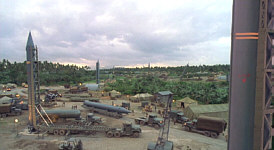 Sharpness generally appeared to be acceptably crisp and detailed, but at times the picture faltered in this regard. Some scenes looked moderately soft and fuzzy, especially during interior shots. As a whole, the image maintained adequate focus for the majority of the film, but some indistinct segments definitely occurred. Occasional use of edge enhancement also appeared, which created a distracting “halo” at times; these instances were fairly rare, but they did occur. Otherwise, I saw no examples of moiré effects or jagged edges.
Sharpness generally appeared to be acceptably crisp and detailed, but at times the picture faltered in this regard. Some scenes looked moderately soft and fuzzy, especially during interior shots. As a whole, the image maintained adequate focus for the majority of the film, but some indistinct segments definitely occurred. Occasional use of edge enhancement also appeared, which created a distracting “halo” at times; these instances were fairly rare, but they did occur. Otherwise, I saw no examples of moiré effects or jagged edges.
In regard to print flaws, Thirteen Days offered an unusual situation for a few reasons. For one, the filmmakers clearly wanted to create a “period” look for the movie, and that impression can be created through grain, scratches and other concerns. Some of the film’s issues may relate to this desire, but frankly, I don’t think this was the case. Examples of those defects occurred sporadically enough to make me believe that they weren’t intentional. Low-light scenes showed the most grain, which is usually a by-product of the dim circumstances, and it didn’t seem to have anything to do with filmmaker’s intent.
In any case, most of the shots filmed for Thirteen Days looked fairly clean and lacked significant concerns. Yes, I saw some examples of the problems mentioned above, but they stayed pretty minor. More noticeable print flaws appeared from time to time, but in most instances they related to archival footage used for the film. For the most part, these integrated well with shots made for the movie itself. At times the older material showed moderate defects, but all in all, they blended neatly with the rest of the film. In any case, the appearance of print flaws in those shots didn’t affect my rating of the image; only problems related to current footage factored in to that equation.
Since so much of Thirteen Days took place within the confines of offices, it didn’t provide a very broad palette, and those interiors indeed looked somewhat bland and drab. However, the hues became more vivid on a few occasions. A Kennedy motorcade showed some nice tones, as did the shots in Cuba. While I felt the interiors demonstrated somewhat inferior colors, they remained within the range of acceptability and were generally decent.
 Black levels came across as slightly flat at times, but they usually appeared to be fairly clear and dark. Shadow detail demonstrated related concerns in that low-light situations were somewhat murky, partly due to the less-than-stellar blacks. Overall, dim scenes seemed to be acceptably visible and opaque, but I thought they lacked the definition I’d expect. As a whole, Thirteen Days offered an image that was perfectly watchable and it could look quite attractive at times. However, the total effect was somewhat disappointing, as the picture didn’t seem as crisp and vibrant as I expected.
Black levels came across as slightly flat at times, but they usually appeared to be fairly clear and dark. Shadow detail demonstrated related concerns in that low-light situations were somewhat murky, partly due to the less-than-stellar blacks. Overall, dim scenes seemed to be acceptably visible and opaque, but I thought they lacked the definition I’d expect. As a whole, Thirteen Days offered an image that was perfectly watchable and it could look quite attractive at times. However, the total effect was somewhat disappointing, as the picture didn’t seem as crisp and vibrant as I expected.
One odd problem occurred as I watched Thirteen Days. At times, many of the DVD features were disabled. The disc would never allow me to alter options “on the fly”; if I wanted to go to a different audio commentary, I was out of luck. While that’s an annoying inconvenience, it’s not unusual; for example, virtually all DVDs from Universal also lock out this kind of switch.
However, if I tried to fast-forward the movie or freeze a frame, on occasion the DVD wouldn’t let me do so. This is a more unusual concern, though not one that happened consistently. At times I was allowed to manipulate the picture, but on others, the DVD refused to respond. Frankly, I think this is a glitch related to the “infinifilm” features I’ll discuss later. It’s not the first time I’ve encountered a DVD that locked out some basic functions; Disney’s two-DVD release of Dinosaur also provided the same problem. Both discs offered “interactive” elements, which seems to be the cause of the concern. Frankly, it wasn’t the end of the world in either case, though it could be annoying. Anyway, I just wanted to mention that you may encounter this problem as you watch Thirteen Days.
To my surprise, I experienced no concerns in regard to the Dolby Digital 5.1 soundtrack of Thirteen Days. Frankly, I expected little from it. After all, this was an office drama that I thought would focus 99 percent of its attention on talking heads. While much of the movie stayed in that vein, enough of it veered in a different direction to make the track extremely satisfying as a whole.
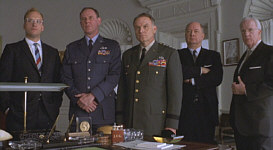 The soundfield provided a very natural and smooth enclosure. During the many dialogue-oriented scenes, a modicum of environmental effects appeared, and these seemed to be accurate and natural. On those occasions, Trevor Jones’ score played the most important role, and the music showed very fine stereo separation.
The soundfield provided a very natural and smooth enclosure. During the many dialogue-oriented scenes, a modicum of environmental effects appeared, and these seemed to be accurate and natural. On those occasions, Trevor Jones’ score played the most important role, and the music showed very fine stereo separation.
When the track required greater effort, however, was when it really came to life. Thirteen Days offered a surprising number of louder scenes; from demonstrations of nuclear explosions to jet missions, the movie featured a lot of good opportunities for audio involvement. Happily, the track lived up to those demands and it provided a terrific environment when appropriate. Jets and other elements moved neatly between channels and they really ratcheted the action up a notch.
During softer scenes, surround usage still seemed positive, as the score spread neatly to the rears, and I also heard decent reinforcement of ambient sounds. However, the surrounds got a much better workout during the louder segments. On those occasions, the rear speakers became active partners in the mix and they made the track seem very involving and engaging.
Audio quality appeared to be consistently excellent. Dialogue was natural and warm, and I heard no problems related to edginess or intelligibility. The music seemed to be bright and dynamic, as the score presented clear, vivid highs and appropriately rich lows. Effects also appeared to be very strong, and the louder scenes packed a serious punch. Those segments offered accurate and realistic audio, and they boasted some fine low-end. Throughout the movie, bass response was clean and tight. Ultimately, I was extremely satisfied with the soundtrack of Thirteen Days.
While New Line have a long history of excellent special edition DVDs, their release of Thirteen Days takes them on a new path in this regard. Thirteen Days appears as their first “infinifilm” title. According to the insert that comes with the DVD, “an infinifilm DVD is a unique, one-of-a-kind viewer-directed experience. You’re in control of what you watch and when you view it!” Since the DVD disables some normal functions and only intermittently allows others, that statement seems ironic. It also makes little sense; when have I not been able to choose when and what I’d watch on a DVD? As far as I recall, none of my other discs came with a little man who put a gun to my head and forced me to check out certain segments. And why is “infinifilm” not capitalized? Did k.d. lang invent it?
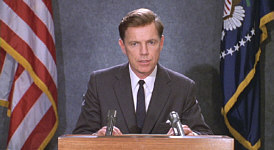 Nonetheless, the “infinifilm” does offer a somewhat different form of presentation. From that same booklet blurb, here’s how the studio describes it: “The movie can also be experienced with the infinifilm option enabled, allowing you to access content specifically relating to the scenes via pop-up prompts that appear. Explore. Escape. Interact. Take your movie-watching experience to a whole new level. Go Beyond the Movie and discover the fascinating facts and intriguing stories surrounding your favorite films! Afterwards, you are returned to the movie right where you left off.”
Nonetheless, the “infinifilm” does offer a somewhat different form of presentation. From that same booklet blurb, here’s how the studio describes it: “The movie can also be experienced with the infinifilm option enabled, allowing you to access content specifically relating to the scenes via pop-up prompts that appear. Explore. Escape. Interact. Take your movie-watching experience to a whole new level. Go Beyond the Movie and discover the fascinating facts and intriguing stories surrounding your favorite films! Afterwards, you are returned to the movie right where you left off.”
Once we get past the marketing hyperbole, what does all of this mean? In essence, the infinifilm feature functions along the same line as other “interactive” features that crop up during a movie. Other discs like the special edition of Dogma, Me, Myself and Irene and Dinosaur used similar functions: when an icon appears onscreen, you press a button and get to watch something that relates to that part of the movie.
In the case of the infinifilm titles, this function becomes more extensive. The icon appears more frequently, since it pops up once per infinifilm chapter stop. While the non-infinifilm version offers 32 chapters, the infinifilm edition provides a whopping 59 stops, and different options appear with each one of those.
How useful is all of this? Moderately, I suppose, but it depends on your tolerance for interruptions. All of the materials accessible during the infinifilm edition can also be found in the standard roster of supplements; there doesn’t appear to be anything exclusive to the infinifilm feature. The advantage to accessing these via the infinifilm function stems from the fact that they’ll relate specifically to that section of the movie. When you see Dean Acheson, you can immediately check out additional information about him. That’s a cool way to make the movie more informative and immediate.
However, it could also be a distraction. It’s hard to get involved in a movie when you leave it every couple of minutes to see something else. Ultimately, however, I think the infinifilm concept is a good one. I can’t say that I’d want to use it while I watched a movie, for I think it’d disrupt the film too much. Nonetheless, I always support additional options, and since I’m not forced to use the feature - and since it makes none of the DVD’s extras exclusive to infinifilm, which would really irritate me - I’m more than happy to see this kind of feature.
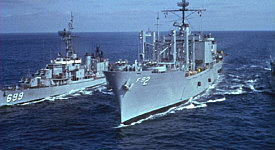 One oddity: while the DVD offers menus for both the normal “Select a Scene” and the “infinifilm Select a Scene”, the latter features the same 32 chapter stops. While it’s nice that the disc broke down the sections in a more detailed manner, it makes no sense that 27 of the infinifilm chapters fail to appear.
One oddity: while the DVD offers menus for both the normal “Select a Scene” and the “infinifilm Select a Scene”, the latter features the same 32 chapter stops. While it’s nice that the disc broke down the sections in a more detailed manner, it makes no sense that 27 of the infinifilm chapters fail to appear.
One annoyance: while the infinifilm process is supposed to make DVDs even more interactive and user-friendly than ever, New Line omitted some very basic helpful pieces on Thirteen Days. For one, the movie includes no subtitles of any sort. Yes, it offers close-captioning, but all DVDs really should have at least English subtitles available.
That alteration was unusual, as I can’t think of another New Line title that lacks subtitles. However, the other concern is more common for their discs. When I delve into the DVD’s supplements, I’ll discuss a few sections that contain a slew of short video pieces. Unfortunately, these don’t provide a “view all” option that would make them much easier to watch. Is it the end of the world to waste a few seconds between clips as the return to the menu when they finish? No, but it’s a nuisance, and it’s a totally unnecessary one. Many other DVDs have “view all” choices that will allow us to check out the pieces uninterrupted; why New Line usually refuse to provide this makes no sense to me.
Thus ends the infinifilm-specific segment of this review. Thirteen Days introduces a few other stylistic innovations, all of which are intended to make the DVD experience more comfortable for folks new to the format. Strewn throughout the disc you’ll find little “?” icons. Click on any of these and you’ll learn about the feature at hand. For example, if you enter the “Filmmaker Commentary” area, you’ll discover a little blurb that tells you about audio commentaries. There’s also a main “Need Help?” menu on the front page. Yes, a lot of this information is very basic, and most DVD fans won’t need it. However, we were all newbies once, and this kind of gentle introduction will be welcome for those who aren’t so familiar with the format.
Now that I’ve covered the manner in which all of the extras are delivered, I can finally address the supplements themselves. Thirteen Days splits its features into two areas: “Beyond the Movie” and “All Access”. The former deals with historical aspects discussed in the film, while the latter more closely covers the movie-making process. Each category includes one audio commentary, and the more traditional offering shows up in “All Access”. That one is called the Filmmaker Commentary and it features director Roger Donaldson, actor Kevin Costner, writer David Self, executive producer Michael DeLuca, producer Armyan Bernstein, and visual effects supervisor Micheal McAlister. All of the men appear to have been recorded together except for Costner who was clearly taped separately.
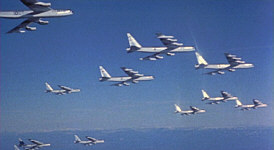 That last factor rendered Costner almost totally moot; he appeared only a few times during the track, and it was strongly dominated by the other men. While the commentary often degenerated into the excessive praise that frequently occurs in this kind of piece, it included enough good information to deserve a listen. I thought it was a nicely chummy program that maintained a genial and fun tone; we even get to hear DeLuca joke about how New Line wanted to cast Jim Carrey and Adam Sandler in the lead roles. I also enjoyed the various recollections of the era addressed in the film; the participants evoked the period well and gave those of us not alive at that time a better idea of what it was like. This wasn’t a great commentary, but I felt it delivered enough useful information about the film and the time to merit my attention.
That last factor rendered Costner almost totally moot; he appeared only a few times during the track, and it was strongly dominated by the other men. While the commentary often degenerated into the excessive praise that frequently occurs in this kind of piece, it included enough good information to deserve a listen. I thought it was a nicely chummy program that maintained a genial and fun tone; we even get to hear DeLuca joke about how New Line wanted to cast Jim Carrey and Adam Sandler in the lead roles. I also enjoyed the various recollections of the era addressed in the film; the participants evoked the period well and gave those of us not alive at that time a better idea of what it was like. This wasn’t a great commentary, but I felt it delivered enough useful information about the film and the time to merit my attention.
The second commentary took a more unusual - and provocative - tone. Located in the “Beyond the Movie” area, this was the Historical Figures Commentary, and it featured a much more factual bent. On this piece, we hear archival statements from President John F. Kennedy, Special Assistant to the President Kenneth O’Donnell, and Secretary of Defense Robert McNamara. In addition, we get new remarks from Kennedy Press Secretary Pierre Salinger, historians Ernest R. May and Phillip D. Zelikow, and Sergei Khrushchev, historian and son of Soviet Premier Nikita Khrushchev. For fairly obvious reasons, all were recorded separately and the results were edited together for this piece.
As a whole, I thought this was a very compelling program. It included a nice discussion of the facts involved during the Crisis, and it also went into a number of details that didn’t make the film. While all of the participants had their moments, I definitely was most interested in what Khrushchev had to say. Thirteen Days presents no information about the Soviet side of the confrontation, and for good reason; they wanted to enhance the tension through a “president’s-eye view” of the events. Had we been privy to the other part of the debate, it would have made the film much less interesting; it’s because we were placed in the same boat as the participants that the movie worked so well.
Nonetheless, this meant that the Soviet point of view didn’t receive any coverage, so it was fascinating to gain some insight into their standpoint. Little Khrushchev proves to be an honest and informative speaker, and his portions of the commentary were quite useful. All of the speakers were good, however, and I thought this was a nicely rich and incisive track.
 Since I liked Khrushchev so much, I was happy to see that he appeared as part of the Roots of the Cuban Missile Crisis, another “Beyond the Movie” feature. This documentary lasts for 48 minutes and 40 seconds and it provides a fine coverage of the events that led up to the Crisis. The show mainly combines archival footage, a few movie scenes, and a slew of recent interview clips. In regard to the latter, we hear from a couple of commentary veterans, as Khrushchev, Salinger, Zelikow, and May from the “Historical Figures” track pop up here; David Self from the “Filmmakers Commentary” also appears. In addition, we get statements from historians Raymond Garthoff and Tad Szulc, former CIA photo interpreter Dino Brugioni, and newspeople Sam Donaldson, Marvin Kalb, Herbert Kaplow, Helen Thomas, and Helen Westwood.
Since I liked Khrushchev so much, I was happy to see that he appeared as part of the Roots of the Cuban Missile Crisis, another “Beyond the Movie” feature. This documentary lasts for 48 minutes and 40 seconds and it provides a fine coverage of the events that led up to the Crisis. The show mainly combines archival footage, a few movie scenes, and a slew of recent interview clips. In regard to the latter, we hear from a couple of commentary veterans, as Khrushchev, Salinger, Zelikow, and May from the “Historical Figures” track pop up here; David Self from the “Filmmakers Commentary” also appears. In addition, we get statements from historians Raymond Garthoff and Tad Szulc, former CIA photo interpreter Dino Brugioni, and newspeople Sam Donaldson, Marvin Kalb, Herbert Kaplow, Helen Thomas, and Helen Westwood.
As with the “Historical Figures Commentary”, this program offered a solid look at the period and the facts. “Roots” really does get into the basics nicely, as it goes back to the World War II era to explore the start of the Cold War and it moves into the Cuban Revolution. Of course, the relative brevity of the piece means that it can’t be tremendously detailed, but I thought it was an informative and interesting program that neatly captured the tone of the era.
We’re not finished with all of these pieces based on the events of the Crisis. Still in the “Beyond the Movie” domain, the Historical Information Track provides a decent little text commentary that can be viewed along with the movie. Sometimes these can be too distracting to check out as you watch the film, but this one proceeds at a leisurely enough pace to make both tasks possible. Unfortunately, that occurs because the “HIT” doesn’t provide a tremendous amount of information; facts pop up occasionally pop not with great rapidity. Many of the details included are fairly pedestrian as well, and the text doesn’t give us much insight. Nonetheless, it does fill in some unstated details about participants and events; I wasn’t happy that I took the time to view it on its own, but as accompaniment for the movie, it could be useful.
Next in “Beyond the Movie”, we find a section that includes Historical Figures Biographical Gallery. This offers short video discussions of a variety of Crisis participants. These are divided into five different areas: “Leaders” (John F. Kennedy, Nikita Khrushchev, and Fidel Castro); “Advisors” (Robert Kennedy, Kenneth O’Donnell, Dean Acheson, McGeorge Bundy, Robert McNamara, Dean McCone, Theodore Sorenson, and Dean Rusk); “Military” (General Maxwell Taylor, General Curtis LeMay); “Diplomats” (Adlai Stevenson, Anatoly Dobrynin); and “Press” (Pierre Salinger, John Scali). Each of these snippets lasts between 49 seconds and two minutes, 34 seconds for a total of about 27 and a half minutes of material. Each incorporates some of the same participants we saw during the “Roots” documentary.
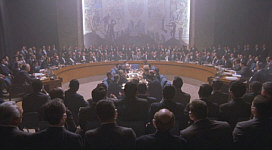 Obviously, the shortness of the various pieces means that they can’t be exhaustive, but I thought these offered a nice little addition to the package. None of them are really biographies in the sense that they give us a true history of the men, but they featured some useful information that fleshed them out for us, especially in regard to their relationships with the Crisis. Text biographies might have been more complete, but these small slices of information still provided some good background.
Obviously, the shortness of the various pieces means that they can’t be exhaustive, but I thought these offered a nice little addition to the package. None of them are really biographies in the sense that they give us a true history of the men, but they featured some useful information that fleshed them out for us, especially in regard to their relationships with the Crisis. Text biographies might have been more complete, but these small slices of information still provided some good background.
That last program finished “Beyond the Movie”, so we can now go into the rest of the “All Access” features “Bringing History to the Silver Screen was a very rapid romp through various aspects of the creation of Thirteen Days. It looked at the script, the acting process, effects, production design and some other areas during its 10 minutes and 35 seconds. How quickly does this show move? Each chapter covers a different subject, and the program includes 16 chapters! That means that nothing gets discussed in detail, which is a disappointment; there’s some good information to be found here, but it all flies by so quickly that it could be hard to keep pace.
Visual Effects gives us a breakdown on one brief scene. After an 80-second “Introduction” from visual effects supervisor Micheal McAlister, we can watch 28 seconds of jet fighter effects during five separate stages: “Plate Without Animation”; “Rough Animation/Greenscreen”; “Flat Color Animation”; “Composite”; “Final Film”. You can use the “angle” button on your remote to switch between stages. The piece was too short to be tremendously informative, but it was a reasonably interesting clip nonetheless.
Deleted Scenes offers nine different examples of footage that didn’t make the final cut. Most of these were totally excised from the movie, but a few show longer versions of existing segments. Each runs between 20 seconds and two minutes, 50 seconds for a total of about 12 and a half minutes worth of clips. All are available with or without commentary from director Roger Donaldson.
Many deleted scenes are dishwater dull, but most of these were really quite interesting. A number of them relate to a minor subplot that involved a journalist, and these were the best of the bunch. Unfortunately, when one went, they all had to go, so we lost a good scene of Greenwood as he neatly expressed the pain JFK suffered even while he had to smile and wave to well-wishers. Donaldson’s commentary does exactly what it should. He succinctly discusses what he’d wanted to say in the unused scenes, and he relates why they were cut. All in all, I was very pleased with this selection of deleted material.
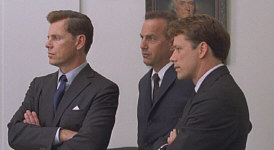 The main supplements of Thirteen Days end with the film’s theatrical trailer plus “Cast and Crew “ filmographies for director Donaldson, screenwriter Self, and actors Costner, Greenwood, Culp, and Dylan Baker. However, viewers with the necessary equipment will be able to access a slew of DVD-ROM materials. “Script to Screen” lets you read the original script while you watch the movie; the video runs in a small screen on the left as the text displays on the right half of the screen. There’s also a link to the Original Website. Unfortunately, unlike many other New Line DVDs, this really is nothing more than a link; some of their other releases included all of the site’s information on the disc itself.
The main supplements of Thirteen Days end with the film’s theatrical trailer plus “Cast and Crew “ filmographies for director Donaldson, screenwriter Self, and actors Costner, Greenwood, Culp, and Dylan Baker. However, viewers with the necessary equipment will be able to access a slew of DVD-ROM materials. “Script to Screen” lets you read the original script while you watch the movie; the video runs in a small screen on the left as the text displays on the right half of the screen. There’s also a link to the Original Website. Unfortunately, unlike many other New Line DVDs, this really is nothing more than a link; some of their other releases included all of the site’s information on the disc itself.
The “Hot Spot” sends you to a New Line site that apparently should offer revolving pieces of information and activities. When I checked out a corresponding page for Dungeons and Dragons, it went to a trivia game that asked questions about a variety of New Line films. However, as I write this five days before Thirteen Days hits stores, the link doesn’t work; hopefully it’ll become active when the DVD officially arrives.
Although it was largely ignored at the box office, Thirteen Days should reach a wider audience via video, and it deserves increased attention. The movie presents a crisp and incisive look at a dramatic period in history, and it made the era come to life through solid pacing, fine acting, and a good attention to detail. While the DVD provides somewhat lackluster picture, the sound seems excellent, and it includes a terrific array of extras. Thirteen Days is a true winner that merits your time and your money.